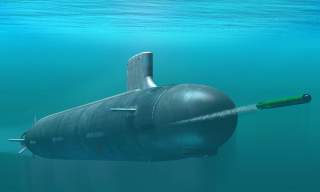Get Ready, China and Russia: The U.S. Navy Is Building 'Super' Torpedoes for Its Nuclear Submarines
Why America's submarines are about to get even more lethal.
Although many details of the new prototype torpedo are secret, senior Navy officials do say modifications include giving the weapon a longer range and a more varied, high-tech warhead.
The U.S. Navy is now prototyping a new, longer range and more lethal submarine-launched heavyweight Mk 48 that can better destroy enemy ships, subs and incoming weapons at longer ranges, service officials said.
Many details of the new weapon, which include newer propulsion mechanisms and multiple kinds of warheads, are secret and not publically available. However, senior Navy leaders have talked to Scout Warrior about the development of the weapon in a general sense.
Naturally, having a functional and more high-tech lethal torpedo affords the Navy an opportunity to hit enemies at further standoff ranges and better compete with more fully emerging undersea rivals such as Russia and China.
Progress with new torpedo technologies is happening alongside a concurrent effort to upgrade the existing arsenal and re-start production of the Mk 48, which had been on hiatus for several years.
The earlier version, the Mk 48 Mod 6, has been operational since 1997 – and the more recent Mod 7 has been in service since 2006.
Lockheed has been working on upgrades to the Mk 48 torpedo Mod 6 and Mod 7 – which consists of adjustments to the guidance control box, broadband sonar acoustic receiver and amplifier components.
Tom Jarbeau, Director and General Manager of Targets, Torpedoes and Sensors, Lockheed Martin, told Scout Warrior in an interview that Lockheed is now delivering 20-upgrade kits per month to the Navy.
Part of the effort, which involves a five-year deal between the Navy and Lockheed, includes upgrading existing Mod 6 torpedoes to Mod 7 as well as buying brand new Mod 7 guidance control sections.
The new Mod 7 is also resistant to advanced enemy countermeasures.
Modifications to the weapon improves the acoustic receiver, replaces the guidance-and-control hardware with updated technology, increases memory, and improves processor throughput to handle the expanded software demands required to improve torpedo performance against evolving threats, according to Navy information on the weapon.
The Mod also provides a significant reduction in torpedo radiated-noise signatures, a Navy statement said.
Alongside Lockheed’s work to upgrade the guidance technology on the torpedo, the Navy is also preparing to to build new Mk 48s.
Upgrades to the guidance control section in includes the integration of a system called Common Broadband Advanced Sonar System, or CBASS – electronics to go into the nose of the weapon as part of the guidance section, Jarbeau explained.
“This provides streamlined targeting and allows the torpedo to transmit and receive over a wider frequency band,” Jarbeau said.
Jarvo added that the new technology involves adjustments to the electronic circuitry in order to make the acoustic signals that are received from the system that allow the torpedo to better operate in its undersea environment.
“Digital information is used to guide the torpedo,” Jarbeau said.
Upgrades also consist of movement to what’s called an “auto fuel propulsion system,” he added.
Lockheed will deliver about 250 torpedoes over the next five years. The Mk 48, which is a heavy weapon launched under the surface, is quite different than surface launched, lightweight Mk 54 torpoes fired from helicopters, aircraft and surface ships.
The Navy’s Mk 48 torpedo is also in service with Australia, Canada, Brazil and The Netherlands, Jarbeau said.
A Mk 48 torpedo is 21 inches in diameter and weighs 3,520 pounds; it can destroy targets at ranges out to five miles and travels at speeds greater than 28 knots. The weapon can operate at depths greater than 1,200 feet and fires a 650-pound high-explosive warhead.
Kris Osborn became the Managing Editor of Scout Warrior in August of 2015. His role with Scout.com includes managing content on the Scout Warrior site and generating independently sourced original material. Scout Warrior is aimed at providing engaging, substantial military-specific content covering a range of key areas such as weapons, emerging or next-generation technologies and issues of relevance to the military. Just prior to coming to Scout Warrior, Osborn served as an Associate Editor at the Military.com. Osborn previously served at the Pentagon as a Highly Qualified Expert with the Office of the Assistant Secretary of the Army - Acquisition, Logistics & Technology. Osborn has also worked as an anchor and on-air military specialist at CNN and CNN Headline News. This story originally appeared in Scout Warrior.

